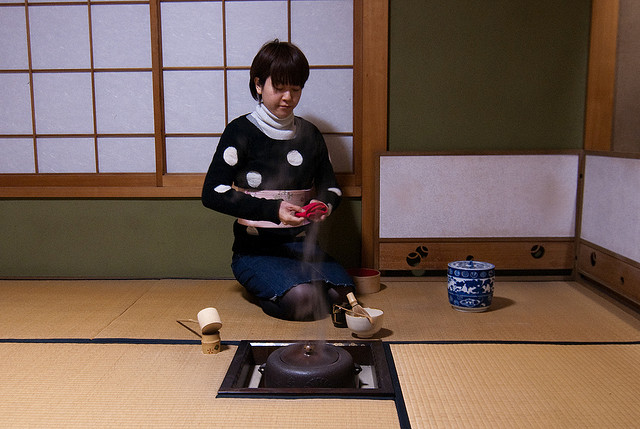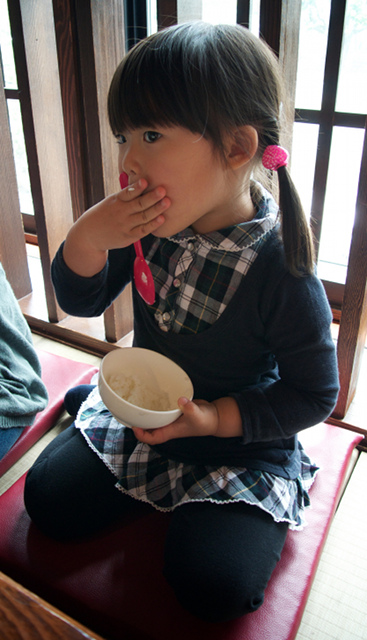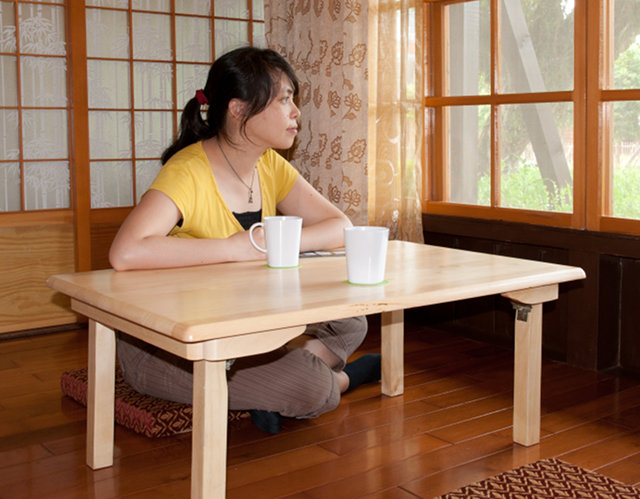Sitting on the Floor

Who needs furniture? This women is making tea in the traditional way, while sitting in the formal seiza position. This way of sitting is so central to the tea ceremony (chado, 茶道), that it has a different name (ryurei, 流麗) if you use a chair instead.
When you’re in Japan, even sitting down can be an exotic experience. Chairs are one of the many foreign technologies that Japan has wholeheartedly adopted, but most Japanese people would just as soon sit on the floor. In fact, you’re more likely to be afforded the luxury of a floor seat at a posh hotel or restaurant than at a cheap one.
It’s because people sit on the floor that you don’t ever wear outside shoes inside. OK, you do wear shoes in shops and many restaurants, but if it’s a floor that’s going to be sat on then shoes are an absolute no-no – that would be the Western equivalent of walking all over your sofa and chairs. Just stepping inside with anything on your feet that has touched the ground outside is a cardinal sin – even if it’s just socks or the soles of your feet. (Apologies to readers from elsewhere in Asia who already understand this – it’s one aspect of civilization that still hasn’t been widely adopted in the West.)
Nowadays most Japanese people do have chairs in their houses, but this might be more because they look modern and cosmopolitan than because of any practical benefit. Many houses have at least one washitsu (Japanese-style room) where the floor is covered with straw tatami mats, and in which there’s no furniture, except maybe a low table or a few cushions. Some houses still have only this kind of room, and no chairs at all, and they’re also common in hotels and restaurants.

Even when using chairs, it’s not uncommon for Japanese people to sit on them in the same way as they would sit on the floor, as this girl is doing while eating in a restaurant.
Where I come from, it’s usually only children who sit on the floor, but that rule absolutely doesn’t apply in Japan. Even when chairs are available, they don’t always get used, as the floor often feels more comfy or relaxing. I do know one person whose biggest complaint about Japan was about having to sit on the floor, but if you’re used to it it’s no bother at all. But here’s a warning – there’s a whole etiquette to sitting down in Japan. How you sit can say as much about you as the words that come out of your mouth. Partly because of this, Japanese has developed a whole vocabulary for describing different ways of sitting.
The polite and formal way to sit is called seiza (正座), kneeling with your legs together, and the tops of your feet flat on the ground. If you’re not used to sitting like this, you might find you get uncomfortable very quickly, and that it’s a real struggle to stay still for more than a few minutes. Increasing numbers of Japanese have this problem too, and one solution is a miniature folding stool that you can discreetly rest your bum on, so taking the weight off your feet. The more common solution is just to sit in a different position.
The most common alternative is probably agura (胡座) – more familiarly known as crossed legs. The characters it’s written with literally mean ‘barbarian-sitting’, but don’t let that put you off. If you’re a man it’s quite acceptable on all but the most formal of occasions, and women often sit this way too. It’s not considered very lady-like, but plenty of women couldn’t care less about that. If you start to get uncomfortable, or just want to wriggle around a bit, you could try changing to tatehiza (立て膝) – sitting with one knee up – good in casual situations, but perhaps not recommended for a formal banquet.
The polite female alternative to seiza is yoko-zuwari (横座り), sitting with your legs to the side, but folded back on themselves. Men sit like this too, but sometimes get teased about being effeminate. Another feminine style is obachan-suwari (おばあちゃん座り) – kneeling with your bum flat on the floor and your legs out to the sides. Obachan-suwari literally translates as ‘grandma-sitting’, because it’s particularly associated with older women, but you see people of all ages sitting like this, especially kids. It’s OK for men too, but not if you want to look suave and manly.
Finally there’s sitting with both knees up in front of you, tai-iku-suwari (体育座り) – literally ‘physical education sitting’. It’s so called because this is how elementary school kids sit during PE lessons. It would be too disrespectful to sit agura (cross-legged) in front of a teacher, and none of the other ways of sitting are very comfortable on the hard floors of gymnasiums. Despite its name, anyone can sit like this – it’s not just for PE.
There are other ways of sitting that aren’t covered here, but these are the common styles that all Japanese people will recognize by name. If you’re really finding it tough, you can always ask for a chair – Japanese people are generally very tolerant of foreigners who find it hard to follow their customs. Just beware that if you spend long enough in Japan you’re likely to join the Japanese in thinking that wearing shoes in your house is a disgusting habit, and you might even come to think of chairs as a total waste of space.
Electric Chrysanthemums Incredible Bridges

